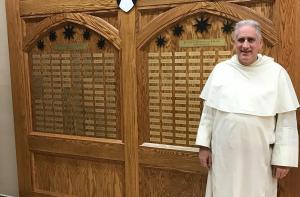Three women’s basketball superstars from Fenwick – Erin Lawless, Devereaux Peters and Tricia Liston — soon will have their numbers hanging from the rafters in the Catholic school’s gym.
Compiled by Mark Vruno
Tricia Liston (from left), Devereaux Peters and Erin Lawless back in their Fenwick days.
In the illustrious, nearly 90-year history of Fenwick High School, only two retired jerseys have been displayed atop the Fieldhouse Gymnasium: those of Heisman Trophy winner Johnny Lattner ’50 (football) and former NBA player Corey Maggette ’98 (boys’ basketball). But that number is about to more than double in a pregame ceremony (2:30 p.m.) on January 13th, when the jersey numbers of three alumnae will be added: Erin Lawless #34, Tricia Liston #32 and Devereaux Peters #14.
“Lattner and Maggette: That’s some elite athletic company,” observes Dave Power, Head Girls’ Varsity Basketball Coach who mentored all three of the honorees when they played for his Friars. “Each of these women is so well deserving of this recognition from our school,” adds Coach Power, now in his 41st year of coaching (first at Proviso West, then at Immaculate Heart of Mary in Westchester).
Power is one of only three 900 (935 now and counting) game-winning basketball coaches in Illinois history, and teams on which the trio of Lawless, Peters and Liston played contributed to nearly 43% of that win total. Keep in mind that Fenwick was an all-boys institution for its first 63 years; it went coed in 1992 – the year Power came to Fenwick. Here, in chronological order, is who these players are, what they did at Fenwick, and what they’ve done since moving on from Oak Park:
#34 Shoots, She Scores!
Lawless played her powerball for the Boilermakers.
Erin Lawless ’03 is no relation to legendary Fenwick Coach Tony Lawless, but the 6’2” Berwyn native set her own reputation as a center on the hardwood. Post-Fenwick, Lawless played in the Big Ten at women’s basketball powerhouse Purdue University. She also played professionally, briefly for the WNBA’s Indiana Fever and then in Europe, where she enjoyed an eight-year career.
As a Friar Lawless won a state championship* (AA) as a sophomore and twice earned first-team All-State honors (as a junior and senior). Other highlights:
- scored more than 2,000 career points in high school
- averaged 21.6 points per game as a senior
- as a junior, averaged 21.5 points, 10.5 rebounds, 4 blocked shots and 3.7 assists (the Friars went 30-4)
- scored a school-record 51 points vs. St. Ignatius
- overall record: 125-12
Lawless was the Chicago Sun-Times Player of the Year in ’03 and a McDonald’s and Nike/WBCA All-American. She was first runner-up for the Chicago Tribune’s Ms. Basketball in Illinois. (Naperville Central junior Candace Parker won her second Ms. Basketball title that year, and would win her third as a senior in 2004. In the ’03 state title game, the Friars lost to Parker’s Redhawks by four points in overtime.) Lawless was named second-team Parade All-American and third-team USA Today All-American.
Such accolades are even more impressive for the tall, former seventh grader — Lawless was 5’11” at age 12 — who started playing hoops on doctor’s orders at Lincoln Middle School (Berwyn). Two years earlier, “I was diagnosed with a rare blood disease called ITP,” she was quoted in a Purdue University publication as a college freshman in 2003. ITP is short for idiopathic thrombocytopenic purpura, an autoimmune disease that causes a low platelet count in the blood. (Sonya Lawless, Erin’s mother, also suffers from the condition.) “My hematologist told me that if I picked up a basketball, it actually builds up my immune system and would help keep me active and keep me healthy,” Lawless said.
Once she caught the basketball bug, Erin’s late Uncle Bud helped her to hone her skills. Fast forward three years, to when Lawless cracked the starting varsity line-up as a Fenwick freshman in 1999-2000. The rest, as they say, is history. The ITP has gone into remission, and basketball probably played a large role in helping to build up her immune system and get the platelet count to a safe level.
Today, Lawless is in her second year of coaching at La Plata High School in Maryland, where she lives with her husband and two-year-old daughter. She also teaches Chemistry and AP Environmental Science. “The team I coach has not had a successful track record, and I am working on changing that for the program,” she reports. The 32-year-old adds, “While I have ‘retired’ from basketball, I continue to get offers to play — and if the opportunity presents itself, I may just go back!”
#14 Perseveres through Adversity
Continue reading “Friars Basketball Legends to Have Jerseys Retired”








 A Class of 1986 alumnus, Fr. Woerter teaches Theology at Fenwick and is the Director of Campus Ministry. Father Dennis (FD) also coaches as an assistant on the sophomore boys’ and junior-varsity girls’ soccer teams. He received a B.A. in speech communication (journalism) from Loras College, a Master of Divinity from the Aquinas Institute of Theology, a M.A. in Theology (Catholic Social Teaching) from the Aquinas Institute and a Doctor of Ministry degree (Preaching in the Practice of Ministry) from the Iliff School of Theology.
A Class of 1986 alumnus, Fr. Woerter teaches Theology at Fenwick and is the Director of Campus Ministry. Father Dennis (FD) also coaches as an assistant on the sophomore boys’ and junior-varsity girls’ soccer teams. He received a B.A. in speech communication (journalism) from Loras College, a Master of Divinity from the Aquinas Institute of Theology, a M.A. in Theology (Catholic Social Teaching) from the Aquinas Institute and a Doctor of Ministry degree (Preaching in the Practice of Ministry) from the Iliff School of Theology.











